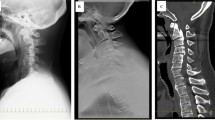Summary
Horizontal cross rotatory tomography has been used with air myelography of the cervical spine to study the pathogenesis of myelopathy in cervical spondylosis.
In an experimental investigation, a model of the neck was made of “Phantom Mix-DP”. The optimum X-ray conditions and the significance of the air shadow were studied by using this model.
Normal air-myelographs were obtained and studied in 25 healthy adults free from abnormalities in the cervical spine or cervical cord, and the areas of the spinal canal were measured using the planimeter.
Horizontal cross rotatory tomography with airmyelography of cervical spine was performed in 57 cases with myelopathy due to cervical spondylosis and ossification of the longitudinal ligament of the cervical spine.
The patients were classified into groups according to morphological findings and the clinical significance of these findings was studied with reference to cord compression.
This technique was valuable as a supplementary investigation for diseases of the cervical spine and the cervical cord.
Résumé
La tomographie axiale transverse après myélographie gazeuse de la colonne cervicale a été utilisée en clinique afin de comprendre la pathogénie de la myélopathie dans la spondylarthrite ankylosante.
Dans un travail expérimental préliminaire, un modèle du cou a été construit avec «Phantom Mix-DP». Les conditions radiographiques optimales ainsi que la signification de l'opacité aérique ont été étudiées à l'aide de ce modèle.
Des myélographies gazeuses normales ont été obtenues et étudiées chez 25 adultes en bonne santé, sans anomalies de la colonne cervicale ni de la moelle et les dimensions des trous de conjugaison ont été mesurées par planimétrie.
Des tomographies axiales transverses sur myélographie gazeuse de la colonne cervicale ont été effectuées sur 57 patients atteints d'une myélopathie due à une spondylarthrite ankylosante et à une ossification du ligament longitudinal cervical.
Les malades ont été classés en groupes selon les résultats morphologiques et planimétriques et la signification clinique de ces résultats a été étudiée en se référant à la compression de la moelle épinière.
Cette méthode est valable en tant que technique complémentaire dans les maladies de la colonne cervicale ainsi que pour l'étude de la moelle cervicale.
Similar content being viewed by others
Author information
Authors and Affiliations
Rights and permissions
About this article
Cite this article
Miura, Y., Nozaki, H., Khono, R. et al. Clinical application of horizontal cross rotatory tomography to air-myelography of cervical spine and its significance in cervical spondylosis. International Orthopaedics 2, 31–38 (1978). https://doi.org/10.1007/BF00266000
Issue Date:
DOI: https://doi.org/10.1007/BF00266000




